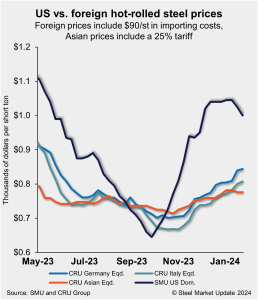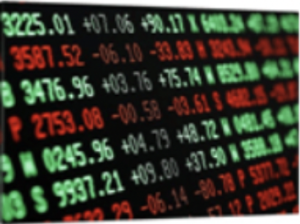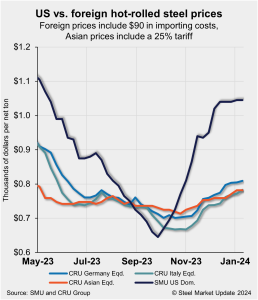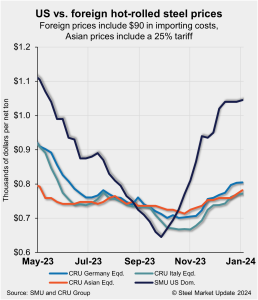December marks second slowest month for imports in 2023
December’s import level was slightly lower than an earlier license count had suggested, resulting in December marking the second-slowest month for imports in 2023.
December’s import level was slightly lower than an earlier license count had suggested, resulting in December marking the second-slowest month for imports in 2023.

Brazilian steel maker Usiminas has resumed operations at blast furnace (BF) No. 3 at its Ipatinga works in the state of Minas Gerais. The restart comes after a BRL2.7-billion ($546-million) refurbishment on the unit, which has capacity of three million metric tons (mt) per year.
The American steel market, including the stainless steel market, continues to face serious threats from subsidized and dumped imports resulting from foreign government policies creating an unfair playing field. It is no secret that China is a major culprit.
The Tampa Steel Conference is just a few days away. Here are some topics I’m looking forward to learning more about during the proceedings on Monday and Tuesday. For starters, we’ll have about a month of 2024 under our belt when we convene on Sunday. How does that compare to what we thought the start of the year would look like? And what’s the outlook for the balance of the year?

US hot-rolled coil (HRC) prices declined further this week, easing to their lowest level since late November. And while domestic tags remain notably more expensive than offshore product, the premium has declined as imported hot band tags have moved higher.
What's being talked about in the US steel market this week?
Steel Dynamics Inc.’s (SDI’s) top executive sees hot band demand remaining strong in 2024, which should support pricing.

SMU’s Jan. 24 Community Chat, featuring CRU's Principal Analyst Erik Hedborg, provided viewers with an update on the current state of the global iron ore market.
US hot-rolled coil (HRC) prices edged down this week while import prices moved higher on average. Domestic hot bands’ premium over cheaper imports declined as a result. But overall, US product remains substantially more expensive than overseas material. All told, US HRC prices are 21.4% more expensive than imports, a premium that is down three […]
What are people in the steel marketplace talking about this week?
There seems to be a growing consensus that the US sheet market has peaked at a high level and could begin losing ground from here. Whether declines happen quickly or whether sheet prices bop around at current levels for a few weeks more is the primary question.
Coming out of a strong fourth quarter, galvanized steel market participants are reporting an above-average start to January and are cautiously optimistic for 2024.
US service center flat-rolled steel inventories surged in December with the seasonal slowdown in shipments. At the end of December, service centers carried 64.8 shipping days of supply, according to adjusted SMU data, up from 54 days in November.
Turkish scrap import prices increased last week with CRU’s assessment for HMS1/2 80:20 at $423 per metric ton (t) CFR, up by $7/t week over week (w/w) but down $2/t month over month (m/m). This was driven by a pickup in buying activity.
It’s been a sloppy start to the year for domestic hot-rolled (HR) coil and ferrous scrap markets. One of the loudest things to happen in HR this year might be something that didn’t happen at all. Namely, Nucor didn’t follow competitor Cleveland-Cliffs higher when Cliffs announced a price hike to start the year.

After a holiday period that saw HR futures volumes somewhat muted in December, the first week of January brought with it increased interest reflected in higher volumes.
Pig iron prices rose month over month (MoM) in all major regions aside from Europe on improved buying. Demand in the US remains robust while market participants report that availability of Brazilian material increased after tightening a month prior. Meanwhile, Ukrainian export capacity increased due to greater access to temporary sea corridors.

US hot-rolled coil (HRC) prices were unchanged this week but remain significantly more expensive than offshore product. While imported hot band tags increased vs. last week, gains were marginal, keeping domestic HRC substantially more expensive than imports. All told, US HRC prices are 24.3% more expensive than imports, a premium that is down only slightly […]
I expected that we’d start off January with prime scrap prices modestly up if for no other reason than industrial activity typically slows down over the holidays. And mills’ appetite for scrap typically increases in anticipation of stronger Q1 order activity.
The US Department of Commerce will likely be lowering the antidumping duty (AD) rates on imports of welded steel pipe from the UAE.
I’d have been surprised if anyone told me just last week that the January scrap market might move lower. What we saw on Friday were offers. Not settlements. And no doubt there are still some twists and turns in store before we can say for sure which way scrap will go.
The Department of Commerce issued its final determination in the trade case involving tin mill products from a handful of countries.
The International Trade Commission (ITC) held a hearing on Thursday, Jan. 4, to consider arguments for and against the imposition of antidumping and countervailing duties (AD/CVDs) on tin mill products from a handful of countries. Both sides made compelling arguments.
SMU polled steel buyers on a variety of subjects this past week, including purchasing practices, steel sheet prices, scrap, and the future market.
After a brief decline in the price of scrap for the Turkish market, which peaked in December at approximately $424 per metric ton (mt) for HMS 80/20, the market has bottomed at $405/mt on cargoes from Europe.
Steel mill lead times pulled back across the board this week but are still said to be at healthy levels, according to SMU's market survey this week.

US hot-rolled coil (HRC) prices moved up again this week and remain significantly more expensive than offshore product.
After falling in November, steel imports appear to have bounced back to a five-month high in December.
SMU doesn’t do forecasts. We leave that to our colleagues at CRU. But we’re pretty good at surveys, and we’ve got a great group of readers. That’s why we decided to ask you what’s in store for 2024. The results are below, along with some insightful comments in italics.
The Mexican government has placed anti-subsidy (CVD) duties of almost 80% on cold rolled (CR) sheets from Vietnam, with the caveat that if the importer can prove the steel comes from a country other than China then it is exempt from the levy.